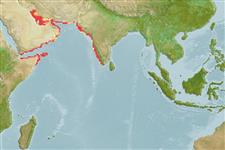Common names from other countries
Environment: milieu / climate zone / depth range / distribution range
Ekologi
marina bottenlevande; djupintervall 10 - 155 m (Ref. 89707). Tropical; 33°N - 8°N, 44°E - 77°E (Ref. 5222)
Western Indian Ocean: Gulf of Aden, Gulf of Oman, Persian Gulf, Pakistan, and west coast of India. Since it has only recently been discovered, it may be expected to have a wider distribution.
Size / Vikt / Age
Maturity: Lm ? range ? - ? cm
Max length : 61.0 cm TL hane/ej könsbestämd; (Ref. 30573); 54.7 cm TL (female); publicerad maxvikt: 0.00 g
Taggstrålar i ryggfenan (totalt) : 11; Mjukstrålar i ryggfenan (totalt) : 16 - 17; Taggstrålar i analfenan: 3; Mjukstrålar i analfenan: 8. Distinguished by the following characteristics: head, body and fins pale, covered with numerous small close-set dark brown spots; spots on fins and dorsal parts of head and body smaller and closer together compared to those on the sides and ventrally; rear edge of caudal fin with white line and a row of blackish brown spots; presence of dark maxillary streak; body depth contained 2.6-3.3 times in SL; body width 1.8-2.4 times in depth; head length 2.5-2.8 times in SL; slightly convex interorbital, dorsal head profile almost straight; angular preopercle, with indentation above the angle and enlarged serrae below the indentation; straight upper edge of operculum; posterior nostrils slightly larger than anterior ones; maxilla reaches to below rear half of eye; front of jaws with a pair of small fixed canines; 2 rows of teeth on midlateral part of lower jaw, inner ones twice length of outer teeth, pyloric caeca 28-34 (Ref. 89707).
Known from rocky areas adjacent to soft bottoms in depths 10-155 m (Ref. 89707). In the Hong Kong live fish markets (Ref. 27253).
Life cycle and mating behavior
Maturities | Reproduktion | Spawnings | Egg(s) | Fecundities | Larver
Heemstra, P.C. and J.E. Randall, 1993. FAO Species Catalogue. Vol. 16. Groupers of the world (family Serranidae, subfamily Epinephelinae). An annotated and illustrated catalogue of the grouper, rockcod, hind, coral grouper and lyretail species known to date. Rome: FAO. FAO Fish. Synop. 125(16):382 p. (Ref. 5222)
IUCN Red List Status (Ref. 130435)
CITES (Ref. 128078)
Not Evaluated
Threat to humans
Harmless
Human uses
Fiskeri: kommersiell
Verktyg
Special reports
Download XML
Internet-källor
Estimates based on models
Preferred temperature (Ref.
115969): 21.9 - 27.1, mean 24.5 (based on 133 cells).
Phylogenetic diversity index (Ref.
82804): PD
50 = 0.5000 [Uniqueness, from 0.5 = low to 2.0 = high].
Bayesian length-weight: a=0.01072 (0.00623 - 0.01842), b=3.02 (2.88 - 3.16), in cm Total Length, based on LWR estimates for this species & Genus-body shape (Ref.
93245).
Trofisk nivå (Ref.
69278): 3.9 ±0.6 se; based on size and trophs of closest relatives
Resiliens (Ref.
120179): Mellan, lägsta populationsfördubblingstid 1,4-4,4 år (K=0.19; tmax=41).
Fishing Vulnerability (Ref.
59153): High to very high vulnerability (67 of 100).
